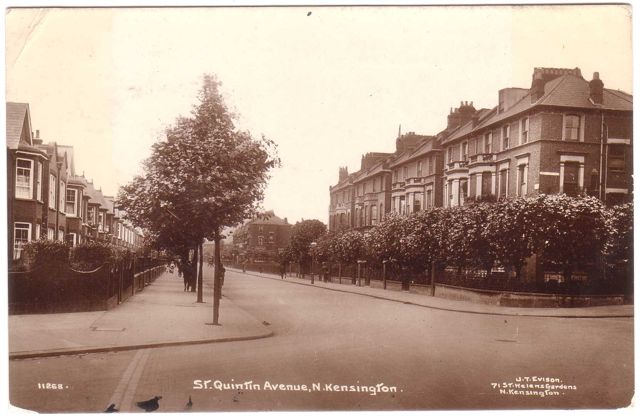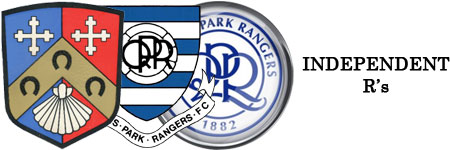At the end of the 1900-01 season the club were forced to move from the Kensal Rise Athletic Ground because the landlord terminated the lease. Largely thanks to one of the Club’s Directors, T. R. Eagle, the R’s, or I should say the Royalists as they were then, moved to a new ground somewhere off of St. Quintin Avenue near Latimer Road.

This move in 1901 was not approved by some of the local residents. In response to this, a Rangers fan from Notting Hill wrote the following letter, dated 4th September, which appeared in the Kensington News & West London Times:
‘Sir, – What is the meaning of the prevailing rumours, that there is a coterie of individuals in North Kensington who are determined to prevent the Queen’s Park Rangers Football and Athletic Club retaining the ground they have acquired in Latimer Road for their football matches ?
One would think that those who had the interests of the northern part of the borough at heart would welcome the advent of a club which is anxious to provide exhibitions of a popular game for the enjoyment of the residents of the district.
Yet, if what I hear is true, there are a few old-fashioned individuals who have banded themselves together to try and put a stop to the introduction of professional football in the borough, because they say it would bring in its train a large number of undesirable characters. But, sir, is that likely ?
I have taken considerable interest in the doings of the Rangers in former years, and my experience has been that those who take pleasure in watching their play, are not people likely to disturb any neighbourhood by unseemly conduct, but who delight in watching an exciting contest between two well-trained teams of footballers merely for the innocent pleasure they get out of it, and because they think it is a splendid pastime beneficial to those who play, and interesting to lookers-on.
The Rangers’ new ground is an almost isolated situation, and even if there is a little natural excitement shown when the various matches are in progress, it is only for about an hour and a-half on each occasion, on an average once a week, counting home and away matches.
As the play gives pleasure to so many, why should two or three individuals step in and try to interfere ?
A Ratepayer – Notting Hill
This enforced move was certainly not ideal for the club. The condition of the pitch was very poor and apparently due to a lack of facilities the players had to change in the ‘Latimer Arms’ before running down the road to the ground, much to the delight of some of the local youngsters who couldn’t afford the penny admission.
During Rangers’ time there the ground was used for a large open air party to celebrate the Coronation of King Edward V11.
Those local residents unhappy at having a professional football club on their doorstep eventually got their way when their petition to the estate owner was successful. He duly served notice on the Rangers to leave at the end of the season.
One of the players, John Bowman, wanted to regain his amateur status, but changed his mind when he was offered the vacant position of Club Secretary and helped with the move back to Kensal Rise.
Steve Russell
(The above pic is taken from my postcard collection and dates from around 100 years ago. Apart from the Kensington News, my other sources of reference include Dennis Signy’s 1969 book: ‘A History of Queen’s Park Rangers’ and Gordon Macey of course)

Great article in respect of the pre Loftus Road nomadic period. The letter shows the social upheaval football was bringing with Rugby considered the ‘Gentleman game’and the new upstart game was considered low class.
Steve,Kerrins and I are busy researching this period and it is interesting to see how the papers of the time only slowly acknowledged and reported on the games.
Martin Percival and I visited whats left of the grounds a couple of years ago.Martin also discovered some really good photos and local maps showing the ground which was also used for cricket matches.It was on a very large piece of land that today locals know as St Marks Park (Kensington Memorial Park) at one end of St Quintins Avenue and West London Bowls Club at the other end. The grounds were carved up in the middle circa 1920 when Princess Louise Hospital was built and Pangbourne Avenue was created.
Did`nt realise St Marks Park was part of QPR History used to play there as a sprog. Great article yet again 🙂
Very good article….and here we all are 112 years later still interested in the “doings of the Rangers”
Probably the most mysterious and hard to research of Rangers’ many grounds. Latimer Road saw the first telephone installed by the club in October 1901, plus a stand built that was then shifted to Kensal Rise when the club moved back there in the summer of 1902. As Chris said he and I had a good wander around the neighbourhood a couple of years ago. The Latimer Arms, aka The Skinner Arms for Steptoe and Son fans, was used as the HQ for visiting teams and I was told once that it was actually the visitors who changed there and that Rangers used the North Pole as their HQ, not that I have found anything that confirms the North Pole story. For many years after that 1 season in Latimer Road a bus was laid on to take fans to Park Royal from the Latimer Arms. A ground and an area we will be researching for many years to come I am sure!
I remember you saying about the phone installation Martin. There is a recorded attendance of 12,000 that season against Tottenham and I had wondered how such a large crowd could be accommodated ? Interesting to read about a Stand and that it was moved to Kensal Rise. It is well documented that the old Ellerslie Road Stand came from Park Royal. ESSEXURs (Colin) found a great pic of a local railway station – St. Quinton Avenue, but it’s copyright).
Interesting that the ground was called “Latimer Road”, although it was some way from the actual road itself! It does explain how I’ve studied old maps of Latimer Road from around that era and not seen any space big enough to be a football pitch. I think St Marks Park was “built” on the centre of the old brickfields and piggeries and came about because the ground was too badly polluted to be used for housing – it must have been bad, as housing was being erected on almost any patch of land in that area: rumour had it there was so much pig & brick residue that solid things left there too long just sunk into the ground. As the ground was useless for anything else, it was left to become a park and recreation are for the working classes.
So it means Rangers were in the s**t in 1901-2 and Mark Hughes picked up that mantle a century or so later.
This long article covers the area.
http://www.british-history.ac.uk/image.aspx?compid=49881&filename=fig81.gif&pubid=363
Good early map (undated) in the first part of the article. (it does enlarge if clicked on!)
Presumably the pitch was on the Recreation Ground noted.
Sorry just realised I have given the enlarged map link only the article is….
http://www.british-history.ac.uk/report.aspx?compid=49881
Steve Russell : that 12,000 crowd vs Spurs was our downfall as the local residents put in a petition about the large crowds which caused congestion and the landlord was forced to kick us out !!
‘Interesting that the ground was called ‚ÄúLatimer Road‚Äù, although it was some way from the actual road itself! It does explain how I‚Äôve studied old maps of Latimer Road from around that era and not seen any space big enough to be a football pitch’.
The site of te pitch was a bout 100 yards from the North Pole boozer. You know where North Pole road meets Barlby Road/St Quintins Ave, theground was behind the houses of both Barlby /St Quintins. It was an open space/park which ran all the way to St Marks Rd. St Marks Pk is all that remains at one end and West London Bowls Club is all that remains at the other(behind the houses). They created Pangbourne Ave and the hospital in the middle of the open space in the 20s but I believe the park was still that size up until then.
Yes, thanks Chris – as you say, a few hundred yards from Latimer Road …. explaining why I couldn’t find anything large enough to provide a ground anywhere along Latimer Road itself.
Martin. Have you found the actually number?
There was a lot of space in a field between Latimer Road and St Quintins Avenue at that time. At the south end was the Latimer Arms pub and at the other end a pavillion that is shown on a old ordnance map. The complaining residents was the only housing in St Quintins Avenue. That space was built up just after Rangers has left ca 1905. Of course it’s not a proof but rather near.
Match photos supposedly from Latimer Road:
http://qprreport.proboards.com/thread/37474/qpr-spurs-28th-december-1901
If it is Latimer Road (and I think it is) then there’s definitely a stand there. A pavilion was built when Rangers moved in as it was mentioned in an interview with the club secretary. I’d love to be able to talk to my grandfather who saw the Rs at Kensal Rise, Latimer Road, Park Royal etc. There’s still so much to be learned about those grounds. Time machine time!